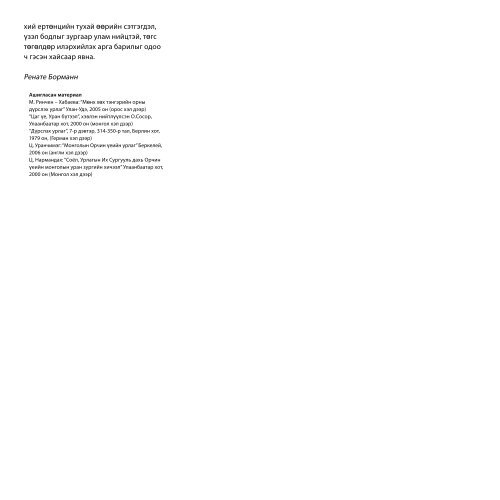Spuren - Gan-Erdene Tsend
Spuren - Gan-Erdene Tsend
Spuren - Gan-Erdene Tsend
Erfolgreiche ePaper selbst erstellen
Machen Sie aus Ihren PDF Publikationen ein blätterbares Flipbook mit unserer einzigartigen Google optimierten e-Paper Software.
хий ертºнцийн тухай ººрийн сэтгэгдэл,<br />
¿зэл бодлыг зургаар улам нийцтэй, тºгс<br />
тºгºлдºр илэрхийлэх арга барилыг одоо<br />
ч гэсэн хайсаар явна.<br />
Ренате Борманн<br />
Ашигласан материал<br />
M. Ринчен – Хабаева: “Мºнх хºх тэнгэрийн орны<br />
д¿рслэх урлаг” Улан-Удэ, 2005 он (орос хэл дээр)<br />
“Цаг ¿е, Уран б¿тээл”, хэвлэн нийтл¿¿лсэн О.Сосор,<br />
Улаанбаатар хот, 2000 он (монгол хэл дээр)<br />
“Д¿рслэх урлаг”, 7-р дэвтэр, 314-350-р тал, Берлин хот,<br />
1979 он, (Герман хэл дээр)<br />
Ц. Уранчимэг: “Монголын Орчин ¿еийн урлаг” Беркелей,<br />
2006 он (англи хэл дээр)<br />
Ц. Нармандах: “Соёл, Урлагын Их Сургууль дахь Орчин<br />
¿еийн монголын уран зургийн хичээл” Улаанбаатар хот,<br />
2000 он (Монгол хэл дээр)<br />
Tsultemiin Enkhjin: “Art is the greatest<br />
and most tender emotion”<br />
Tsultemiin Enkhjin, born in Ulaanbaatar in<br />
1953, unites rationality and emotion like<br />
few other modern Mongolian painters in artworks<br />
of great expressiveness and elegance.<br />
His earlier works reflect a “Mongolian” view<br />
of the world, but one that never becomes<br />
folkloristic, and his subsequent works increasingly<br />
transformed into expressionistic<br />
works of art that were specifically situated<br />
in their time and place and were both<br />
sensuous and mysterious at the same time.<br />
Enkhjin shifts nimbly between abstract<br />
and figurative compositions. The colouring<br />
fluctuates between strong, rich, warm reds<br />
and yellows and cool blues. White is present<br />
in all his pictures, and black symbolises pure<br />
strength.<br />
As the son of Nyam-Osoryn Tsultem (1924 –<br />
2001), one of Mongolia’s most famous 20th<br />
century painters, and Ch. Ichinkhorloo, a<br />
geography teacher, he, his twin brother<br />
Munkhjin and his younger sisters, Narmandakh<br />
and Uranchimeg, were surrounded from<br />
birth by art, artists and more or less heated<br />
discussions on the state of the world, art and<br />
politics. Munkhjin and Narmandakh became<br />
painters like Enkhjin; Uranchimeg became<br />
an art historian and scholar. They grew up<br />
in an atmosphere of tension between the<br />
artistic and cultural scene of those times<br />
and the socialist-communist cultural policy<br />
of the People’s Republic. And they grew up<br />
knowing the long artistic traditions of the<br />
peoples who have populated Mongolia for<br />
millennia. Testimonies to the earlier visual<br />
artists range, on the one hand, from rock<br />
paintings through 14th century Persian-<br />
Mongolian painting, Buddhist-Lamaistic<br />
images of saints and pictures on temple<br />
banners, with their evocative and meditative<br />
message, all the way to, on the other hand,<br />
traditional Mongolian painting (“Mongol<br />
Zurag”), which as well as scenes of nomadic<br />
life, depict fight scenes, animals, demons,<br />
magic invocations and ritual sacrifices.<br />
Open compositions that show many people<br />
shepherding, slaughtering, making felt,<br />
hunting, celebrating and in domestic scenes<br />
in large two-dimensional forms, often portrayed<br />
from a humorous point of view, predominated<br />
until well into the 20th century.<br />
B. “Marsan” Sharav (1869 –1939) stands at<br />
the beginning of realistic modern Mongolian<br />
painting, although stylistically he adhered<br />
to traditional Mongolian art until his death.<br />
His drawings turned to nature early, portraying<br />
real faces and events. However, Sharav,<br />
the “mocker”, was not just a painter; he was<br />
also a graphic artist, putting his posters,<br />
which were designed in the tradition of<br />
Tibetan religious woodcuts, at the service of<br />
the Revolution and the power of the people.<br />
At first sight, “Ein Tag im Leben der Mongolen”<br />
(“A Day in the Life of the Mongols”),<br />
the most famous painting by Sharav and of<br />
Mongolia, and Enkhjin’s ‘window paintings’,<br />
for example, seem to have little in<br />
common. Here, the people and animals are<br />
portrayed in a representational way in front<br />
of “yerts” (round, felt-covered structures)<br />
on the steppe; they are seen in panorama<br />
in a composition that is completely based<br />
on colours and forms. Still, this impression<br />
of a flat expanse with clearly-contoured<br />
lines unites both artists. Nomadic art, which<br />
is dominated by decorative elements, was<br />
gradually transformed into professional, realistic<br />
art. If the main initial influence came<br />
from revolutionary Russian artists who were<br />
followers of Abstraction, Suprematism and<br />
Constructivism, by 1932 at the latest, socialist<br />
realism was also regarded as the only appropriate<br />
artistic genre for Mongolia. Only<br />
after Stalin’s death in 1953 was the pressure<br />
on artists somewhat relaxed. Nevertheless,<br />
Mongolian painters – from Sharav through<br />
Namkhaitseren, to Tsultem and Gavaa – still<br />
succeeded to a large degree in maintaining<br />
their aesthetic standards and passing them<br />
on to their successors.<br />
Just as Namkhaitseren and his fellow students<br />
set out for Europe in 1926 to acquire<br />
the knowledge, technology and culture of<br />
a world foreign to them, Mongolia sent<br />
its young people abroad after the Second<br />
World War. They went primarily to Eastern<br />
European countries, such as Bulgaria,<br />
Czechoslovakia, Hungary and GDR as well<br />
as, of course, to the Soviet Union, to study<br />
practical subjects. But they also went to<br />
study the fine arts.<br />
81 Tsultemiin Enkhjin


